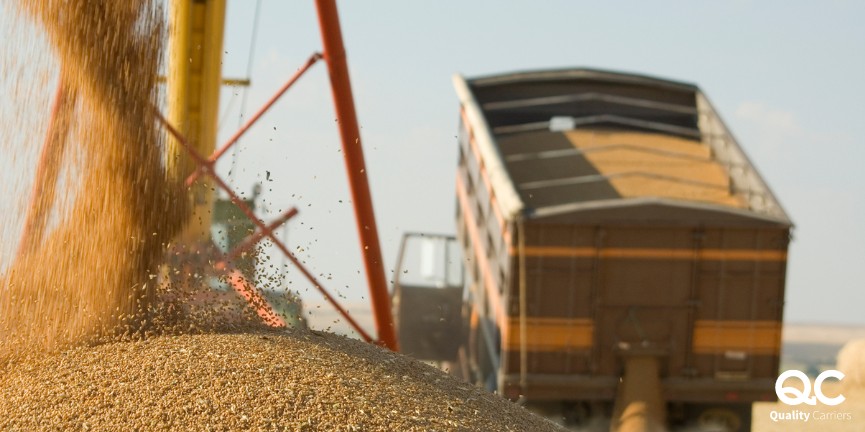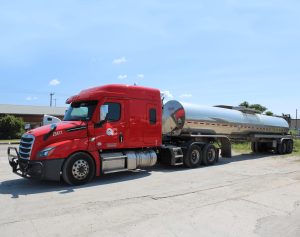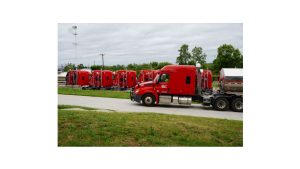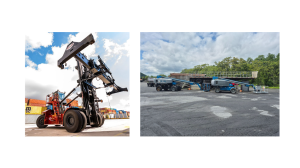Dry bulk drivers are crucial in transporting various granular and powdered materials, from grains and cement to sand and chemicals. Behind the wheel of specialized vehicles, these drivers navigate unique challenges to ensure the safe and efficient delivery of dry bulk cargo.
In this guide, we’ll explore the equipment used by dry bulk drivers and the essential features that enable them to carry out their vital tasks.

Dry Bulk Transportation
Dry bulk transportation is the movement of loose, dry commodities such as grains, minerals, cement, sand, and chemicals in large quantities. This specialized form of transportation requires equipment designed to handle bulk materials efficiently and safely. Dry bulk transportation methods typically include dry bulk trailers, pneumatic trailers, hopper trailers, and dump trailers, each suited for different types of cargo and loading/unloading processes.
What is A Dry Bulk Driver?
Dry bulk drivers are professionals responsible for transporting loose, granular materials such as grains, minerals, cement, and chemicals using specialized equipment. They operate dry bulk trailers, pneumatic trailers, hopper trailers, or dump trailers to transport these materials to various locations, including agricultural sites, construction sites, manufacturing facilities, and mining operations. Dry bulk drivers must ensure the safe loading, transportation, and unloading of materials while adhering to transportation regulations and safety protocols. They also conduct routine inspections, maintenance, and repairs on their equipment to ensure optimal performance and safety on the road.
Dry Bulk Equipment Overview
Dry bulk drivers rely on various specialized trailers to transport granular and powdered materials efficiently and safely. Each type of equipment serves a unique purpose in the dry bulk transportation industry.
1. Dry Bulk Trailers
These trailers specialize in transporting dry bulk materials in large quantities. They are commonly used in agriculture, construction, and manufacturing industries. Dry bulk trailers typically have a large enclosed tank with a single compartment, allowing for efficient loading and unloading of bulk materials. They often have air suspension systems and pneumatic discharge valves to transport various dry goods.
2. Pneumatic Trailers
Pneumatic trailers are designed to transport dry bulk materials that can be discharged using compressed air. These trailers typically have multiple compartments to allow for the simultaneous transport of different types of materials. They use a pneumatic system to pressurize the cargo, allowing it to be unloaded through hoses or pipes at the destination. They are commonly used to transport cement, sand, flour, and plastic pellets.
3. Hopper Trailers
Hopper trailers are versatile trailers commonly used to transport bulk commodities such as grains, gravel, and agricultural products. They feature a large, open-top container with sloped sides resembling a hopper. This is designed to quickly load and unload materials through the bottom of the trailer. Hopper trailers are often equipped with hydraulic systems that enable the bottom doors to be opened or closed for controlled discharge of the cargo.
4. Dump Trailers
Dump trailers are rugged trailers designed for transporting and dumping bulk materials. They feature a hydraulic system that lifts the trailer bed, allowing the cargo to be quickly and easily unloaded at the desired location. These trailers transport materials such as gravel, soil, and debris in construction, landscaping, and agriculture. They come in various sizes and configurations to suit different hauling needs.

Key Features of Dry Bulk Equipment
Dry bulk equipment, including trailers and trucks, offers several key features designed to facilitate the efficient transport of bulk materials. Some of the key features include:
- Large Capacity: Dry bulk equipment is designed to handle large quantities of materials efficiently, allowing for cost-effective transportation of bulk goods.
- Versatility: Dry bulk equipment can transport a wide range of materials, including grains, aggregates, powders, and liquids, and it is adaptable to various industry needs.
- Efficient Loading and Unloading: Dry bulk equipment, equipped with specialized features such as bottom discharge doors, hydraulic systems, or pneumatic discharge valves, facilitates easy and controlled material loading and unloading.
- Durable Construction: Constructed from robust materials like steel or aluminum, dry bulk equipment is built to withstand heavy-duty use, ensuring longevity and reliability in demanding environments.
- Compliance with Regulations: Dry bulk equipment complies with industry regulations and standards, ensuring safety and environmental protection. It guarantees lawful and secure operation while meeting regulatory obligations.
Conclusion
Dry bulk drivers rely on specialized equipment to transport a wide range of granular and powdered materials efficiently and safely. Understanding the different types of equipment and their key features is essential for ensuring the smooth operation of dry bulk transportation operations. Dry bulk drivers can continue to meet the growing demand for their vital services in various industries by investing in durable, well-maintained equipment and adhering to industry best practices.
FAQs
What is dry bulk equipment used for?
Dry bulk equipment transports loose, granular materials such as grains, minerals, cement, and chemicals.
How do dry bulk trailers differ from other types of trailers?
Dry bulk trailers are designed to carry dry bulk materials in large quantities, while pneumatic trailers use compressed air to unload materials. Hopper trailers have a bottom discharge for
What industries commonly use dry bulk equipment?
Industries such as agriculture, construction, manufacturing, and mining commonly use dry bulk equipment.
How do dry bulk drivers load and unload materials?
Dry bulk drivers typically load materials using conveyor belts or loaders and unload them using gravity, pneumatic systems, or hydraulic lifts.
What are some common challenges faced by dry bulk drivers?
Common challenges for dry bulk drivers include navigating narrow roads, managing heavy loads, handling equipment malfunctions, and adhering to strict delivery schedules.




